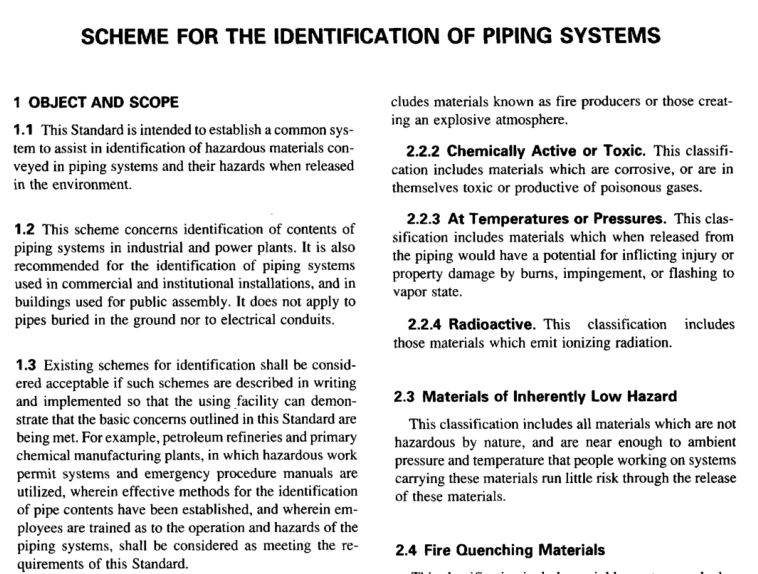ASME A13.1:1996 pdf free download SCHEME FOR THEIDENTIFICATION OFPPING SYSTEMST
1 OBJECT AND sCoPE
1.1This Standard is intended to establish a common sys-tem to assist in identification of hazardous materials con-veyed in piping systems and their hazards when releasedin the environment.
1.2 This scheme concerns identification of contents ofpiping systems in industrial and power plants. It is alsorecommended for the identification of piping systemsused in commercial and institutional installations,and inbuildings used for public assembly. It does not apply topipes buried in the ground nor to electrical conduits.
1.3 Existing schemes for identification shall be consid-ered acceptable if such schemes are described in writingand implemented so that the using facility can demon-strate that the basic concerns outlined in this Standard arebeing met. For example, petroleum refineries and primarychemical manufacturing plants, in which hazardous workpermit systems and emergency procedure manuals areutilized,wherein effective methods for the identificationof pipe contents have been established, and wherein em-ployees are trained as to the operation and hazards of thepiping systems, shall be considered as meeting the re-quirements of this Standard.
2 DEFINITIONS AND REFERENCES2.1 Piping Systems
For the purpose of this Standard, piping systems shallinclude pipes of any kind and, in addition, fittings, valves,and pipe coverings. Supports,brackets,or other acces-sories are specifically excluded from applications of thisStandard. Pipes are defined as conduits for the transportof gases,liquids, semiliquids, or fine particulate dust.
2.2 Materials Inherently Hazardous
2.2.1 Flammable or Explosive.This classifica-tion includes materials which are easily ignited. It in-
cludes materials known as fire producers or those creat-ing an explosive atmosphere.
2.2.2 Chemically Active or Toxic. This classifi-cation includes materials which are corrosive, or are inthemselves toxic or productive of poisonous gases.
2.2.3 At Temperatures or Pressures. This clas-sification includes materials which when released fromthe piping would have a potential for inflicting injury orproperty damage by burns, impingement,or flashing tovapor state.
2.2.4 Radioactive. This classification includesthose materials which emit ionizing radiation.
2.3 Materials of lnherently Low Hazard
This classification includes all materials which are nothazardous by nature,and are near enough to ambientpressure and temperature that people working on systemscarrying these materials run little risk through the releaseof these materials.
2.4 Fire Quenching Materials
This classification includes sprinkler systems and otherpiped fire fighting or fire protection equipment. This in-cludes water (for fire fighting), foam, CO2, Halon,etc.
2.5 References
This Standard is supplemented by the following stan-dard. Since revisions in and additions to this Standard dooccur, the edition bearing the latest date of issue shall beused. It is expected that best current practice will prevail.The following standard shall, to the extent specifiedherein, form a part of this Standard.
ANSI Z535.1 Safety Color Code
Publisher: American National Standards Institute,Inc.
1 1 West 42nd Street
New York, NY10036
3 METHOD OF IDENTIFICATION
3.1 Legend This Standard considers legend to be primary and ex- plicit for identification of contents. Positive identification of the contents of a piping system shall be by lettered legend giving the name of the contents in full or abbre- viated form (see Table 1). Arrows shall be used to indi- cate direction of flow. Contents shall be identified by leg- end with sufficient additional details such as temperature, pressure, etc., as are necessary to identify the hazard.
Legend shall be brief, informative, pointed, and sim- ple for greatest effectiveness. Legends shall be applied close to valves or flanges and adjacent to changes in di- rection, branches, and where pipes pass through walls or floors; and at intervals on straight pipe runs sufficient for identification. Identification may be accomplished by stenciling, the use of tape, or markers. In any situation, the number and location of identification markers shall be based on the particular piping system. (See Fig. 1.)
3.2 Color Color should be used to identify the characteristic haz- ards of the contents (see Table 2). Color should be dis- played on, or contiguous to, the piping by any physical means, but its use shall be in combination with legend. Color may be used in continuous, total length coverage or in intermittent displays.
ASME A13.1:1996 pdf free download
